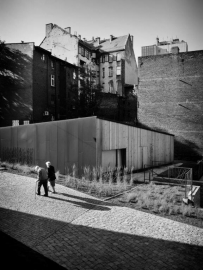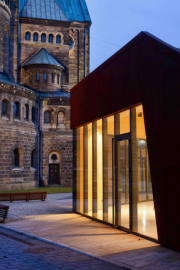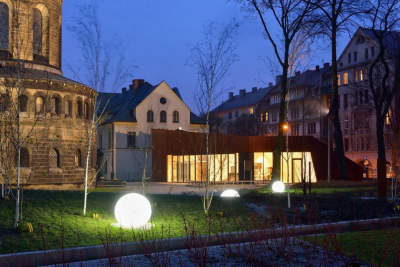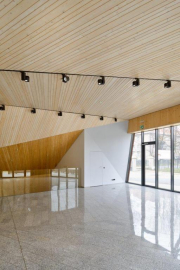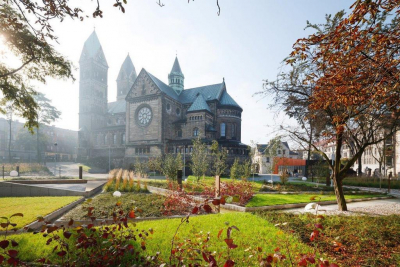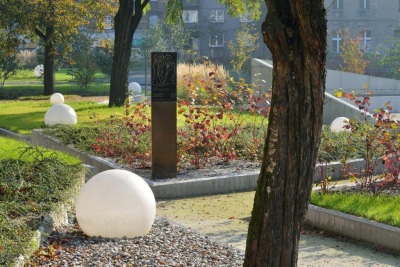Cultural and Educational Centre and Rosary Garden at the St. Hyacinth Church
Within socially and economically degraded centre of Rozbark district in Bytom, on the initiative of the parish, a new public space dedicated to the local community has been established, as a place for contemplation and leisure and also a complex of modern buildings containing multi-functional rooms designed for the youth work, exhibitions and concerts.
The space adjacent to the church has been functionally and aesthetically linked to the terrain of the former green square in order to create a Rosary Garden, referring to the local legend of Saint Hyacinth.
The terrain of the religious nature makes a composition, which becomes a background for the monumental edifice of the temple.
Apart from the Garden, the main elements of the complex are two pavilions connected to the cultural - educational activities run by the parish.
The designed buildings hold religious common rooms, as well as some exhibition areas and spaces for short musical - theatrical forms.
Both of the buildings as inherent parts of the site plan, thanks to the contemporary stylistics along with the modern materials, contrast with the Neo-Roman temple. At the same time, through the form and the scale, the historical meaning hierarchy of the place is held.
The idea of the Garden refers to the figure of Saint Hyacinth, known as a teacher of the rosary. Thus, the sacral elements represented by rosary boards have been arranged along the pedestrian alleys and Marian Grotto along with the water feature have been put in the central part of the plot.
Twenty lightning spheres referring to the rosary legend complement the composition. They are meant to be a meeting place of religious nature. In view of the location and the way it was previously used, the plot has been contemporarily shaped in order to create a common ground a garden of daily leisure and recreation. Restrained geometric layout of the pots has been supported with the plants, fluctuation of which provides contemplation-friendly place, while upgrading aesthetical value of the surrounding as a trademark of the city. Widely arranged pure stand of the plants, wooden terraces as well as some mineral surfaces allow the beholder to read the project goals easily and turning chaotically composed terrain into this friendly space. The preservation of the historic stand of trees allow the new elements match the context landscape.
The building next to the parish house hosts the rehearsal room, stage (building A) and the backstage facilities. The pavilion is covered with multi-hipped green roof and placed in a location, which would prevent it from obscuring the historical church. The building faces the church with a glazing easy to open, when it is needed. It allows the ground floor to become a roofed exterior scene during summer time. The main purpose for the surroundings was the continuation of the existing urban-architectural composition. A natural extension of the ground floor interior is the external area next to the glazing structure of the pavilion. In order to close the space assigned to the audience, a bench in the corner of the plot has been proposed. This piece of the street furniture is meant to invite. Since the building itself contains rooms for many diverse events from theatrical, through musical to exhibitions, its interiors received restrained and friendly finishing, such as wood and large-scale printouts, illustrating a few moments from the history of the place.
The building B, containing common space along with accommodation rooms has been proposed in order to provide support and maintenance. To reduce an impact on the existing historical church and the parish house, the building structure has been partially placed underground, with just one storey left above the ground and also it has been covered with a vegetal roof. The design of the building is intended to be stylistically complementary to the whole complex.
The goal was to reinvigorate the socially and economically degraded area, eventually followed by giving it back to the local community. The project has been prosecuted with all the best actual standards taken into account. Rainwater from all the terrain and from the roofs is kept in a storage reservoir placed underground. It was already being used during the construction process. These days it is used to water the plants in the garden. Both buildings are covered with the vegetal roofs, which not only make them fit well in the context of the historical temple, but also provide them the climate comfort and environmentally friendly approach.
Size of the site:
Garden 4475 m2
Church and Parish hall plot 7648 m2
Gross floor area:
Building A 521,03 m2
Building B 181,06 m2



